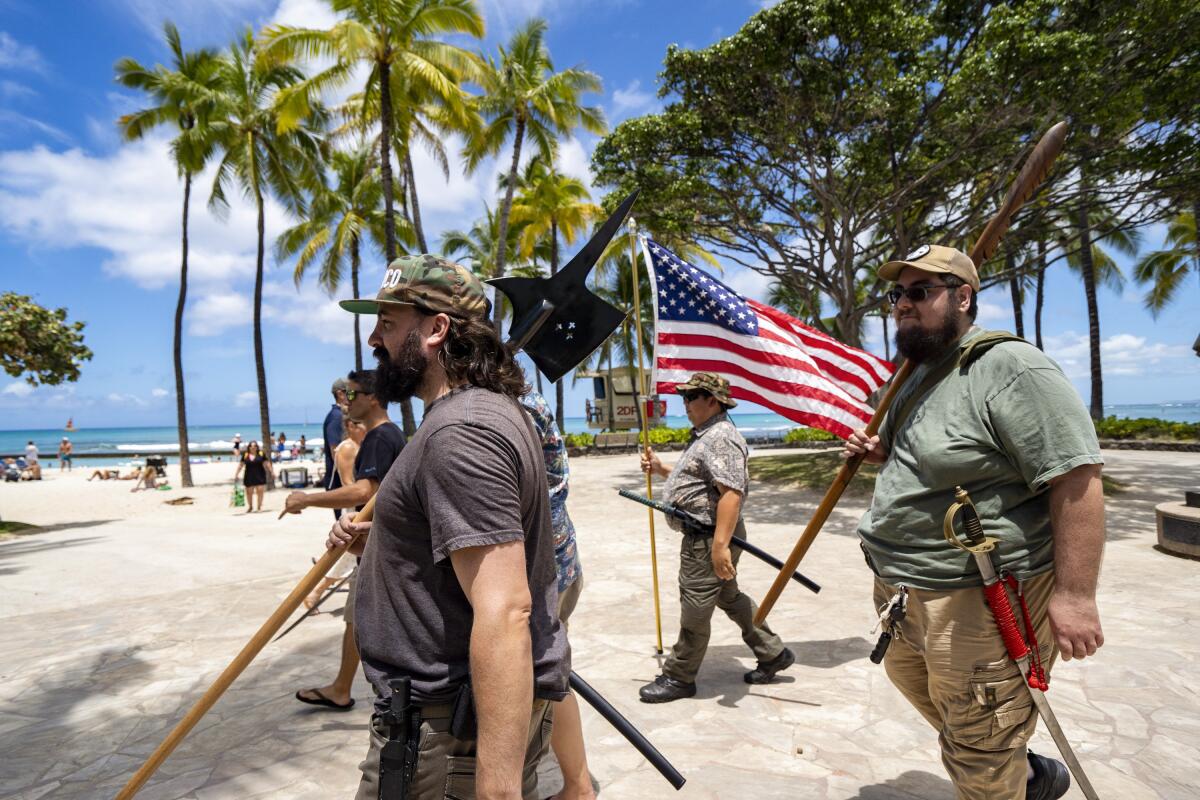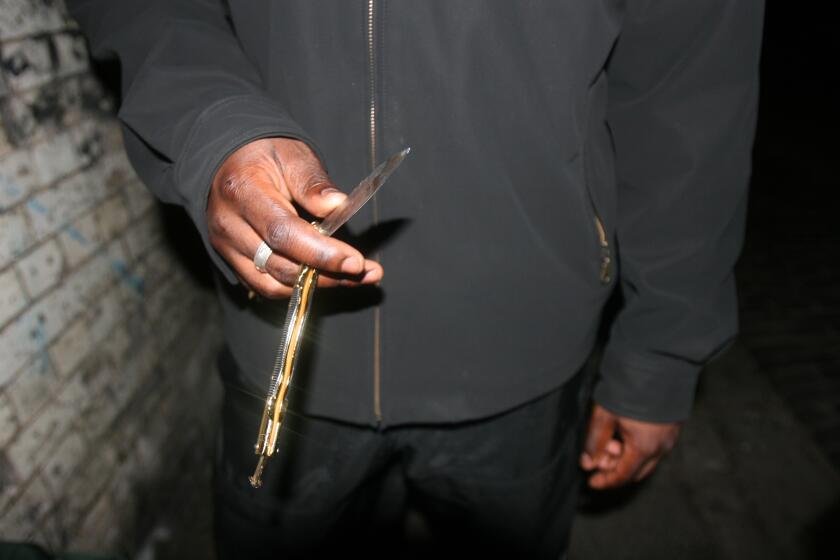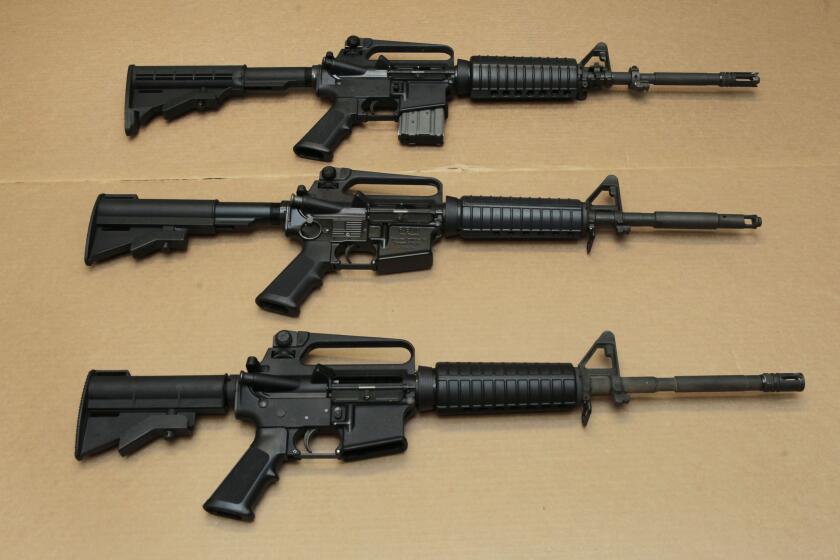Bikinis, surfboards and battle-axes? Hawaii loosens strict weapons laws after court ruling

- Share via
HONOLULU — Hawaii’s tourist hot spot of Waikiki is known for bikinis, shopping and surfboards. But resident Andrew Roberts has recently introduced a different item on evening walks through his neighborhood: a long-poled battle-axe.
Roberts, director of the nonprofit Hawaii Firearms Coalition, has been taking the 15th century-style European halberd on strolls since May. That’s when Hawaii loosened its weapons laws in response to the U.S. Supreme Court’s 2022 decision that Americans have a right to carry firearms in public for self-defense.
The so-called Bruen decision upended gun laws nationwide, but especially in Hawaii, which long had some of the country’s toughest restrictions — and some of the lowest rates of gun violence.
A subsequent federal appeals court ruling applied Bruen to the state’s ban on butterfly knives and found it unconstitutional. While that case and others related to Hawaii’s weapons laws continue to be litigated, lawmakers responded this year by passing a measure that generally allows deadly or dangerous weapons to be openly carried in public. Previously, anyone found armed with them was subject to immediate arrest.
A federal court ruled Hawaii’s 30-year ban on butterfly knives is unconstitutional under the U.S. Supreme Court’s new “history and tradition” standard.
The new law is providing opportunities for some to connect with Native Hawaiian and other cultures through traditional weapons. It’s also generating concern that as the display of weapons becomes more common, people will be more likely to use them.
Roberts called himself a “true believer in the 2nd Amendment.” He said his walks with the halberd or a shorter battle-axe help promote awareness of the laws and ensure police don’t give him a hard time about being armed with unusual weapons.
“I get stopped probably two or three times on an average evening walk and just have a conversation about what gun laws are in Hawaii and what the weapons laws are,” he said.
On a recent Saturday morning, a halberd-toting Roberts gathered with other coalition members in Waikiki’s sprawling Kapiolani Park. A few carried samurai swords. One had a butterfly knife — also known as a balisong, prominent in martial arts in the Philippines, where many Hawaii residents have roots. A wooden, Scottish sword dangled from the waist of a man in a red kilt.
Beginning Saturday, a new law prohibits carrying a gun on the sand — and in other places, including banks, bars and restaurants that serve alcohol.
Honolulu police officers, who got wind of the coalition’s plans to march through Waikiki in celebration of the law, chatted with them. Roberts told one he got his halberd blade on Amazon for $56.
With officers escorting them, they strolled along Waikiki’s main oceanfront drag, Kalakaua Avenue. Some tourists did double takes, but many seemed unfazed by the armed men bearing a large U.S. flag.
“Nobody’s been overly shocked,” Roberts said. “It’s just an opportunity to talk to people about what’s going on in Hawaii, talking about 2nd Amendment rights.”
In a statement, the Hawaii attorney general’s office stressed that the new law didn’t create a free-for-all when it comes to carrying weapons in public.
“The notion that you can just carry weapons however and wherever you want is simply not correct,” it said. “There are numerous existing laws and regulations that govern the use and possession of weapons in many respects. All of these laws will continue to be enforced.”
Supreme Court refused to hear a gun-rights claim that could have struck down California’s ban on rapid-fire assault rifles.
It remains a misdemeanor to carry the weapons in a concealed fashion, and the law increased the penalties for carrying them while committing a crime. It’s also illegal to carry a weapon in a way that threatens harm or terrorizes other people.
While bladed weapons and clubs are not as dangerous as firearms, they don’t belong on the street, said Chris Marvin, a Hawaii resident with the gun-violence prevention group Everytown for Gun Safety.
“I totally can understand the self-defense argument that people make and I would rather they choose to use a knife or a blunt instrument over a firearm, but the cultural attitude that we’re starting to adopt is not the norm for Hawaii,” he said. “In making these laws, we’re becoming more and more like the mainland, which is full of aggressive, argumentative people who resort to violence too quickly.”
Michael Rice carried a wooden spear on his hourlong bus ride to the Waikiki gathering. Studying traditional weaponry such as the spear, which his uncle made from koa wood, has helped him connect to his Native Hawaiian roots: “I don’t get to express my culture that often.”
A Supreme Court ruling that struck down restrictions on firearms is now being used to challenge long-standing state bans on blades, blunt instruments and other weapons.
Soleil Roache, a self-defense instructor who did not attend the march, said the law now allows her to incorporate the balisong into her lessons and to learn about its importance in the Philippines, where her grandfather was from. The law gives her the “opportunity to dive into that part of my ancestry,” she said.
Filipino martial arts instructor Burton Richardson said he can now teach and practice in public parks using weapons, including balisong. “In the Philippines, the tradition of knife, stick and sword fighting ... has been important to the culture,” he said.
The weapon has two pivoting handles that open and close, like butterfly wings, and aficionados make deft work of flashing the blade.
Umi Kai, who makes traditional Hawaiian weapons such as spears, daggers and clubs, was not part of the walk. He mostly uses the implements for ceremony or education; they’re impractical for self-defense in modern Hawaii, he said.
“For self-defense I wouldn’t be carrying around a shark-tooth-laden club every day,” he said.
Sinco Kelleher writes for the Associated Press.
More to Read
Sign up for Essential California
The most important California stories and recommendations in your inbox every morning.
You may occasionally receive promotional content from the Los Angeles Times.













